 String Quartet, Op. 20 is an early work characterized by fierce rhythmic energy. The composition emphasizes ensemble unisons and parallel writing to great effect, but there are also brief explorations of a more contrapuntal, choral style of writing that can be found in its more tranquil moments. The sudden, jerking changes in tempo and sections of spiraling chromatic chaos help to create an athletic composition that demands focus and cohesiveness from the entire ensemble.
String Quartet, Op. 20 is an early work characterized by fierce rhythmic energy. The composition emphasizes ensemble unisons and parallel writing to great effect, but there are also brief explorations of a more contrapuntal, choral style of writing that can be found in its more tranquil moments. The sudden, jerking changes in tempo and sections of spiraling chromatic chaos help to create an athletic composition that demands focus and cohesiveness from the entire ensemble.
In the 3 Poems of Francis Carco (1886-1958), Ramette’s opus 3 composed in 1944, each piece presents a different aspect of his manner of compositional writing. In the first work, the baritone sings a simple step-wise motion, in a modal style close to the Gregorian Chant, while the ensemble accompanies with post romantic harmonies. In the second piece, the gloomy text is spoken, not sung, while the piano accentuates the tragic emotion with more modernist harmonies. The last work unites both facets, highlighting the use of classical melody built on top of a nontraditional harmony, one of Yves Ramette’s compositional characteristics. The whole work expresses a poignant feeling.
In Violin Sonatas 1 & 2 (Op. 18 and 23), Ramette displays his full understanding of the expressiveness of the violin, which is in turn bright and soaring, quiet and reflective, and forceful and energetic. The pieces are composed of distinct and colorful ‘scenes’ characterized by recurring and evolving rhythmic motives in the violin supported by the full, open chords of the piano. Sonata No. 1 carries a dedication to Marcel Despard, a colleague and fellow composer.
The Cello Sonata presents some characteristics of the French Impressionist Era. The work begins with a kind of cadenza, the cello sweetly playing subtle rhythms and lush harmonies, a soft whisper floating in the listener’s ear. The piano, providing a contrasting timbre, responds with ambiguous chord combinations. This sonata offers a distinct voice from Ramette’s previous post-romantic violin sonatas, highlighting a rubato tempo and more abstract harmonies. This sonata offers a distinct voice from Ramette’s previous post-romantic violin sonatas, highlighting a rubato tempo and abstract harmonies.
© NAVONA RECORDS LLC. ALL RIGHTS RESERVED.
Navona Records offers listeners a fresh taste of today's leading innovators in orchestral, chamber, instrumental, and experimental music as well as prime pieces of classic repertoire. Our music is meticulously performed by the finest musicians and handpicked to ensure the most rewarding listening experience.
223 Lafayette Road
North Hampton NH 03862
PRESS INQUIRIES
press (at) parmarecordings.com
603.758.1718 x 161